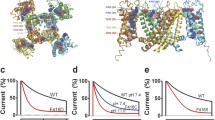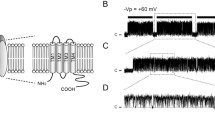Abstract
Internal Mg2+ blocks many potassium channels including Kv1.5. Here, we show that internal Mg2+ block of Kv1.5 induces voltage-dependent current decay at strongly depolarised potentials that contains a component due to acceleration of C-type inactivation after pore block. The voltage-dependent current decay was fitted to a bi-exponential function (τfast and τslow). Without Mg2+, τfast and τslow were voltage-independent, but with 10 mM Mg2+, τfast decreased from 156 ms at +40 mV to 5 ms at +140 mV and τslow decreased from 2.3 s to 206 ms. With Mg2+, tail currents after short pulses that allowed only the fast phase of decay showed a rising phase that reflected voltage-dependent unbinding. This suggested that the fast phase of voltage-dependent current decay was due to Mg2+ pore block. In contrast, tail currents after longer pulses that allowed the slow phase of decay were reduced to almost zero suggesting that the slow phase was due to channel inactivation. Consistent with this, the mutation R487V (equivalent to T449V in Shaker) or increasing external K+, both of which reduce C-type inactivation, prevented the slow phase of decay. These results are consistent with voltage-dependent open-channel block of Kv1.5 by internal Mg2+ that subsequently induces C-type inactivation by restricting K+ filling of the selectivity filter from the internal solution.








Similar content being viewed by others
References
Armstrong CM, Palti Y (1991) Potassium channel block by internal calcium and strontium. J Gen Physiol 97:627–638
Armstrong CM, Taylor SR (1980) Interaction of barium ions with potassium channels in squid giant axons. Biophys J 30:473–488
Baukrowitz T, Yellen G (1995) Modulation of K+ current by frequency and external [K+]: a tale of two inactivation mechanisms. Neuron 15:951–960
Baukrowitz T, Yellen G (1996a) Two functionally distinct subsites for the binding of internal blockers to the pore of voltage-activated K+ channels. Proc Natl Acad Sci USA 93:13357–13361
Baukrowitz T, Yellen G (1996b) Use-dependent blockers and exit rate of the last ion from the multi-ion pore of a K+ channel. Science 271:653–656
Biermans G, Vereecke J, Carmeliet E (1987) The mechanism of the inactivation of the inward-rectifying K current during hyperpolarising steps in guinea-pig ventricular myocytes. Pflugers Arch 410:604–613
Cecchi X, Wolff D, Alvarez O, Latorre R (1987) Mechanisms of Cs+ blockade in a Ca2+-activated K+ channel from smooth muscle. Biophys J 52:707–716
Chen FSP, Steele D, Fedida D (1997) Allosteric effects of permeating cations on gating currents during K+ channel deactivation. J Gen Physiol 110:87–100
Choi KL, Aldrich RW, Yellen G (1991) Tetraethylammonium blockade distinguishes two inactivation mechanisms in voltage-activated K+ channels. Proc Natl Acad Sci USA 88:5092–5095
De Biasi M, Hartmann HA, Drewe JA, Taglialatela M, Brown AM, Kirsch GE (1993) Inactivation determined by a single site in K+ pores. Pflugers Arch 422:354–363
del Camino D, Holmgren M, Liu Y, Yellen G (2000) Blocker protection in the pore of a voltage-gated K+ channel and its structural implications. Nature 403:321–325
Demo SD, Yellen G (1991) The inactivation gate of the Shaker K+ channel behaves like an open-channel blocker. Neuron 7:743–753
Eaton DC, Brodwick MS (1980) Effects of barium on the potassium conductance of squid axon. J Gen Physiol 75:727–750
Elinder F, Liu Y, Arhem P (1998) Divalent cation effects on the Shaker K+ channel suggest a pentapeptide sequence as determinant of functional surface charge density. J Membr Biol 165:183–189
Fedida D (1997) Gating charge and ionic currents associated with quinidine block of human Kv1.5 delayed rectifier channels. J Physiol 499:661–675
Gomez-Hernandez JM, Lorra C, Pardo LA, Stuhmer W, Pongs O, Heinemann SH, Elliott AA (1997) Molecular basis for different pore properties of potassium channels from the rat brain Kv1 gene family. Pflugers Arch 434:661–668
Guo D, Lu Z (2002) IRK1 inward rectifier K+ channels exhibit no intrinsic rectification. J Gen Physiol 120:539–551
Harris RE, Isacoff EY (1996) Hydrophobic mutations alter the movement of Mg2+ in the pore of voltage-gated potassium channels. Biophys J 71:209–219
Horie M, Irisawa H, Noma A (1987) Voltage-dependent magnesium block of adenosine-triphosphate-sensitive potassium channel in guinea-pig ventricular cells. J Physiol 387:251–272
Hoshi T, Zagotta WN, Aldrich RW (1991) Two types of inactivation in Shaker K+ channels: effects of alterations in the carboxy-terminal region. Neuron 7:547–556
Loots E, Isacoff EY (2000) Molecular coupling of S4 to a K+ channel’s slow inactivation gate. J Gen Physiol 116:623–636
Lopatin AN, Nichols CG (1994) Internal Na+ and Mg2+ blockade of DRK1 (Kv2.1) potassium channels expressed in Xenopus oocytes. Inward rectification of a delayed rectifier. J Gen Physiol 103:203–216
Lopez-Barneo J, Hoshi T, Heinemann SH, Aldrich RW (1993) Effects of external cations and mutations in the pore region on C-type inactivation of Shaker potassium channels. Receptors Channels 1:61–71
Ludewig U, Lorra C, Pongs O, Heinemann SH (1993) A site accessible to extracellular TEA+ and K+ influences intracellular Mg2+ block of cloned potassium channels. Eur Biophys J 22:237–247
Matsuda H (1991) Effects of internal and external Na+ ions on inwardly rectifying K+ channels in guinea-pig ventricular cells. J Physiol 460:311–326
Matsuda H, Saigusa A, Irisawa H (1987) Ohmic conductance through the inwardly rectifying K channel and blocking by internal Mg2+. Nature 325:156–159
Ogielska EM, Zagotta WN, Hoshi T, Heinemann SH, Haab J, Aldrich RW (1995) Cooperative subunit interactions in C-type inactivation of K+ channels. Biophys J 69:2449–2457
Olcese R, Latorre R, Toro L, Bezanilla F, Stefani E (1997) Correlation between charge movement and ionic current during slow inactivation in Shaker K+ channels. J Gen Physiol 110:579–589
Rasmusson RL, Morales MJ, Castellino RC, Zhang Y, Campbell DL, Strauss HC (1995) C-type inactivation controls recovery in a fast inactivating cardiac K+ channel (Kv1.4) expressed in Xenopus oocytes. J Physiol 489:709–721
Rettig J, Wunder F, Stocker M, Lichtinghagen R, Mastiaux F, Beckh S, Kues W, Pedarzani P, Schroter KH, Ruppersberg JP (1992) Characterization of a Shaw-related potassium channel family in rat brain. EMBO J 11:2473–2486
Sanguinetti M, Jiang C, Curran ME, Keating MT (1995) A mechanistic link between an inherited and an acquired cardiac arrhythmia: HERG encodes the IKr potassium channel. Cell 81:299–307
Tammaro P, Smirnov SV, Moran O (2005) Effects of intracellular magnesium on Kv1.5 and Kv2.1 potassium channels. Eur Biophys J 34:42–51
Thompson J, Begenisich T (2001) Affinity and location of an internal K+ ion binding site in Shaker K channels. J Gen Physiol 117:373–384
Thompson J, Begenisich T (2003) Functional identification of ion binding sites at the internal end of the pore in Shaker K+ channels. J Physiol 549:107–120
Vandenberg CA (1987) Inward rectification of a potassium channel in cardiac ventricular cells depends on internal magnesium ions. Proc Natl Acad Sci USA 84:2560–2564
Wang Z, Hesketh JC, Fedida D (2000) A high Na+ conductance state during recovery from inactivation in the K+ channel Kv1.5. Biophys J 79:2416–2433
Wang S, Morales MJ, Qu YJ, Bett GC, Strauss HC, Rasmusson RL (2003) Kv1.4 channel block by quinidine: evidence for a drug-induced allosteric effect. J Physiol 546:387–401
Yellen G, Sodickson D, Chen TY, Jurman ME (1994) An engineered cysteine in the external mouth of a K+ channel allows inactivation to be modulated by metal binding. Biophys J 66:1068–1075
Zhou M, Morais-Cabral JH, Mann S, MacKinnon R (2001) Potassium channel receptor site for the inactivation gate and quaternary amine inhibitors. Nature 411:657–661
Acknowledgments
We thank Yan Liu and Fifi Ka-Kee Chiu for the preparation of cells. T. W. Claydon is supported by a Postdoctoral Fellowship funded by a Focus on Stroke strategic initiative from The Canadian Stroke Network, the Heart and Stroke Foundation, the CIHR Institute of Circulatory and Respiratory Health and the CIHR/Rx&D Program along with AstraZeneca Canada. D. C. H. Kwan is supported by the Michael Smith Foundation and by a Postgraduate Scholarship from NSERC. Supported by research grants from CIHR and the HSF (DF) and NSERC (SK).
Author information
Authors and Affiliations
Corresponding author
Additional information
Thomas W. Claydon and Daniel C. H. Kwan contributed equally to the manuscript.
Rights and permissions
About this article
Cite this article
Claydon, T.W., Kwan, D.C.H., Fedida, D. et al. Block by internal Mg2+ causes voltage-dependent inactivation of Kv1.5. Eur Biophys J 36, 23–34 (2006). https://doi.org/10.1007/s00249-006-0085-3
Received:
Revised:
Accepted:
Published:
Issue Date:
DOI: https://doi.org/10.1007/s00249-006-0085-3




